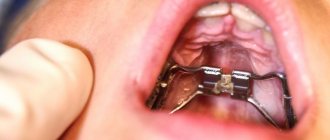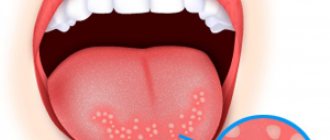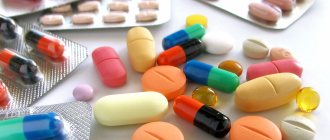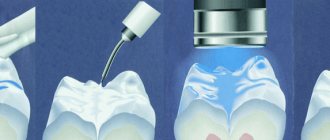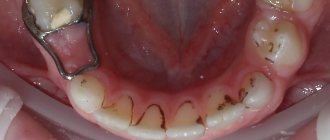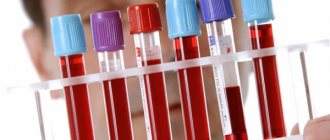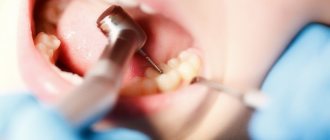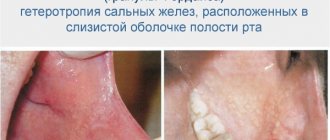Quite often, during illness, the doctor prescribes a course of antibacterial drugs for children. But these products are not vitamins, but are serious medications that, despite their high effectiveness in combating various diseases, can cause serious disorders in the body. Therefore, quite often children experience thrush after taking antibiotics. It can manifest itself on the mucous membranes of the mouth, intestines or genitals.
Symptoms of thrush in a child
Depending on the location of the disease, the symptoms of thrush will vary. To summarize the signs of a fungal infection, we can highlight the following:
- the presence of a white coating in the child’s mouth, which is difficult to remove as the disease spreads;
- regurgitation, colic, loose stools;
- refusal to eat (breast milk, bottles), weight loss due to loss of appetite;
- An increase in temperature not associated with viral and colds is rarely observed;
- the presence of ulcers and wounds on the mucous membrane of the cheeks, on the tongue and lips.
During treatment with antibiotics, the beneficial microflora dies, and if it is not restored in time, then we can expect that the symptoms of thrush will appear in the near future. The child becomes capricious and sleeps poorly, worries and refuses to eat.
Below are detailed symptoms of thrush depending on location.
Taking antibiotics can cause two types of oral thrush - persistent and recurrent. Visually it is easy to identify thrush in the form of a cheesy coating on the gums, tongue, and mucous surface of the cheeks. If you remove the plaque, bleeding wounds are found underneath.
Due to painful sensations, the child is capricious and refuses to eat. If you don’t catch it in time, the fungus will spread to the throat, lips, and corners of the mouth. If the tonsils are damaged, a fungal sore throat begins - the tonsils become covered with a white coating, and the temperature usually does not rise.
Children's skin is very delicate and sensitive, so fungi parasitize it very easily. As soon as the immune system is weakened by taking antibiotics, fungi begin to actively multiply. Often, symptoms of thrush on the skin appear between the buttocks, in the groin folds, on the chest and shoulders.
Skin affected by the fungus dries out and becomes rough, and small red spots with clear contours appear. Over time, bubbles appear. If the fungus is not treated, the spots spread and merge into one lesion. The affected areas are very itchy, the child cries and worries. In rare cases, the fungus affects the skin around the eyes, causing the eyelids to swell, redness of the eyes and excessive tearing.
Fungi affect different parts of the body and organs, and do not bypass the intestines. Signs of thrush in the intestines will be: increased gas formation, loose stools with the presence of white flakes. Children may have stomach pain, refuse to eat, and have disrupted sleep schedules. Thrush occurs, as in previous cases, against the background of disturbed microflora after taking antibiotics.
The child's body is characterized by increased sensitivity to various bacterial infections. Unfortunately, it is impossible today to cure most of these diseases without the help of antibiotics. But antibacterial drugs, while destroying pathogenic microbes in the baby’s body, also have a detrimental effect on his beneficial microflora, consisting of lactobacilli and bifidobacteria.
As a result of this process, the child's immunity decreases, and he becomes defenseless against new ailments. One of them is thrush (otherwise known as candidiasis), a disease caused by excessive development of the yeast-like fungus Candida. In children, after antibiotic therapy, the disease most often affects the mucous tissues of the oral cavity and intestines. In girls, candidiasis can also develop on the genitals.
Thrush in the mouth is called thrush. This type of disease is the most common consequence of taking antibiotics. It appears as a white or yellowish coating on the tongue, gums, inner cheeks and lips. In addition to plaque, small painful ulcers may be observed in these areas, causing discomfort to the baby.
The intestinal form of candidiasis is indicated by symptoms such as pain in the abdomen, colic, flatulence, diarrhea, and the presence of white flaky clots in the child’s stool. In girls, antibiotic therapy can provoke a pathogenic process in the genitals. It can be suspected if the baby has white discharge with a characteristic sour milk smell from the vagina, causing her a burning sensation and itching.
How to treat candidiasis in a child that occurs after a course of antibiotic therapy? This question often arises among parents who have noticed signs of this disease in their baby. Experts advise mothers and fathers of the baby not to panic, since his disease, although unpleasant, is quite curable. If you have thrush, you should never self-medicate. Only a qualified specialist should prescribe medications for it, so at the first symptoms of the disease, parents should go with their child to the clinic.
Thrush in a child is manifested by the following symptoms:
- A white or slightly yellowish cheesy consistency is observed in the mouth.
- Girls may experience white, cheesy discharge from the vagina that has a sour odor. In this case, the child is tormented by almost permanent itching or burning.
- Possible digestive system disorders: diarrhea, flatulence, colic.
- Formations in the form of white flakes are noticeable in the stool.
- The child begins to eat poorly, as a result of which body weight decreases.
- Without any symptoms of a cold, your temperature may rise.
- Small ulcers are possible on the mucous membrane of the tongue and cheeks.
As soon as a child is born, his immunity is still too weak and not sufficiently developed to withstand the attack of various pathogenic microorganisms and viruses. That's why children often get sick.
During the first year of life, the baby's parents will face many worries and trials, as they will have to visit the doctor several times, take tests, take preventive measures and treat the child. Pediatricians prescribe antibiotics to treat diseases.
Antibiotics affect not only pathogenic microorganisms; their side effect is a decrease in the number of beneficial lacto- and bifidobacteria.
Due to an imbalance in the microflora, yeast-like fungi, called opportunistic fungi, begin to actively multiply, and against their background, thrush is already diagnosed in a child after antibiotics. If treatment is not started in time, the course of the disease will enter the chronic stage, against the background of which inflammatory processes and allergic reactions may develop.
With insufficient or improper treatment, thrush can affect the internal organs of the child, in severe cases leading to blood poisoning. In girls in infancy, vaginal thrush can cause fusion of the labia.
Thrush poses the greatest danger to premature babies.
The disease can be called sex-selective, since women are more likely to suffer from it. The causative agent of thrush is the candida fungus, it affects the skin and mucous membranes (mouth, genitals, intestines, lungs). Thrush often occurs on the genitals. Normally, a woman's vagina contains a certain number of yeast-like fungi. When conditions are favorable for them, their growth may begin, and there is a risk of complications.
You can find out that thrush has appeared by burning and itching in the genital area. It is important that you should not scratch the itchy areas, as this will lead to deep penetration of the infection. During thrush, a woman may notice unusual vaginal discharge, the consistency of which resembles cottage cheese. The color of the discharge is white or cream, the discharge has a sour odor.
Manifestations of candidal infection during or after taking an antibacterial regimen are acute and have a clear clinical picture. General health does not suffer. The severity of the condition is determined by the initial state of health.
Symptoms of fungal infection cause extremely unpleasant sensations, psychological and physical discomfort, but allow you to lead a normal life. The clinical manifestations of the pathology that arose after taking antibiotics do not differ from the symptom complex of the acute form of candidiasis against the background of other predisposing factors.
The most common form of candidal infection after taking antibiotics. Women get sick twice as often, which is due to the more important role of normal vaginal microflora.
For women For men
| Severe itching in the genital area | Severe itching in the glans and foreskin area |
| Unpleasant sensations, discomfort in the perineum even at rest | Discomfort when wearing underwear and walking |
| Burning, slight soreness of the labia | Moderate burning sensation, which intensifies with movement of the foreskin |
| Copious, crumbly or curdled discharge that is whitish-gray or yellowish in color | A whitish-yellow filmy or islet coating on the head, less often – cheesy clots |
| Moderate redness, swelling in the affected area | Swelling, redness of the glans and foreskin |
| Burning sensation, pain when urinating | |
| Mild to moderate pain during intercourse | |
Click on photo to enlarge
More often occurs when taking medications by mouth and (or) treating inflammatory processes in the oral cavity. Thrush after antibiotics in the mouth usually affects the tongue, less often the cheeks and corners of the lips. If there is a chronic form of inflammation of the pharyngeal tonsils (tonsillitis), then the candidiasis infection will also invade them.
Symptoms of thrush in adults and children
When taking antibiotics, thrush appears unexpectedly, the symptoms are vivid, and it is impossible not to notice them. The main clinical manifestations of thrush in women:
- Severe itching and burning in the affected area. Scratching is strictly prohibited, otherwise the infection will spread further.
- Vaginal discharge. In appearance they resemble cottage cheese. Color ranges from white to cream. The smell is slightly sour.
- Inflammation of the skin and mucous membranes of the genital organs is observed. Hyperemia and swelling occur.
- Hygienic manipulations cause severe discomfort, even pain.
- A whitish coating appears on the damaged areas (rarely).
Due to constant discomfort, a woman becomes anxious, nervous and irritable. Emotional lability with mood swings is revealed.
While taking antibiotics, men may also develop thrush. Compared to women, this happens somewhat less frequently. When urinating, there is severe pain and a burning sensation. There is plaque on the head of the reproductive organ, swelling, hyperemia, and inflammation form. Constant discomfort in the intimate area.
It’s worth knowing: when taking antibiotics, thrush manifests itself not only in the intimate area, but also affects the oral cavity and other mucous membranes.
We suggest you familiarize yourself with the smell of sewage from your mouth
Main reasons
Infants and children aged 3 to 7 years are susceptible to candidiasis. In infants, this disease can develop in the following cases:
- as a consequence of the mother’s illness during pregnancy, when Candida fungi rise up and penetrate the amniotic fluid;
- during childbirth;
- with insufficient treatment of the baby's nipples, bottles and toys;
- while taking drugs that have an antibacterial effect.
- as a consequence of maternal illness during pregnancy, when Candida fungi rise and penetrate into the amniotic fluid;
- during childbirth;
- with insufficient treatment of the baby's nipples, bottles and toys;
- while taking drugs that have an antibacterial effect.
Causes of thrush in children:
- passage through the birth canal of a mother suffering from thrush;
- too dry and warm air, under such conditions any infection will spread quickly;
- period of tooth growth;
- taking antibiotics that upset the balance between opportunistic and beneficial flora;
- unbalanced diet of a breastfeeding mother (consuming a large amount of rich and sweet foods), especially in combination with antibacterial therapy;
- prematurity of the baby;
- immunodeficiency states;
- changes in hormonal levels in adolescents;
- wearing synthetic panty liners;
- hypothermia and the presence of chronic infections.
4 types of thrush in children:
- Oral thrush;
- Cutaneous candidiasis;
- Intestinal thrush;
- Mycotic vulvovaginitis in girls.
Prevention of thrush when taking antibiotics
When carrying out antibacterial therapy, it is important to follow some rules to protect your baby from thrush:
- Maintaining personal hygiene, timely washing and changing diapers;
- Limit the consumption of fast carbohydrates (soda, store-bought sweets);
- Simultaneously with antibiotic treatment, start taking vitamins and medications to prevent dysbiosis and thrush (as prescribed by a doctor);
- Accustom your baby to fermented milk products;
- Maintain comfortable humidity and temperature in the room. If the air is too dry, use a humidifier;
- Carry out wet cleaning and ventilate the room every day;
- During treatment of thrush in an infant, it is recommended to limit the wearing of diapers.
It is important for parents to remember that uncontrolled and improper use of antibiotics can undermine the baby’s health.
Antibacterial therapy begins only after consulting a doctor and taking tests.
Why do antibiotics cause thrush?
You need to know how antibiotics work to prevent unpleasant consequences. Antibiotics aim to kill bacteria. They affect both pathogenic and beneficial microorganisms. For this reason, the attending physician should prescribe antibiotics after weighing the pros and cons of treatment.
Antibiotics are active in the intestines, where bacteria digest food. Bacteria are sensitive to various drugs, so they die under the influence of drugs. Instead, opportunistic and pathogenic bacteria, including candida fungi, begin to multiply.
Antibiotics act systemically on the body because they are absorbed into the blood. As a result, all organs are affected, including the mucous membranes of the mouth and genitals. Therefore, fungal growth is observed there, unpleasant symptoms begin to appear, and without treatment, complications begin to appear.
Thrush after antibiotics how to treat
Almost every person has had to take antibiotics at least once in their life. And this is not surprising, because antibacterial agents effectively fight pathogens of various diseases. And more and more often you can hear about such a phenomenon as thrush from antibiotics.
However, the use of antibiotics has not only positive aspects; the “other side of the coin” is the risk of complications, among which candidiasis can be identified.
Why does thrush occur from antibiotics?
Thrush from antibiotics can occur for a number of reasons, namely:
- long course of treatment;
- failure to comply with exact dosages;
- independent choice of drug, etc.
As you know, yeast-like fungi are natural inhabitants of the human body. Their moderate amount does not cause any diseases. This is strictly monitored by our immune system; it does not allow opportunistic microflora to increase and form colonies.
Prevention of candidiasis
If measures are not taken in time, treatment with antibiotics leads to an imbalance in the balance of beneficial and harmful microorganisms in the child’s microflora. More often, due to an imbalance of microflora, thrush of the gastrointestinal tract and genital organs develops. Treatment should be aimed at getting rid of Candida fungi and restoring normal levels of microflora.
Girls are prescribed local antifungal drugs to treat genital thrush. Most often these are clotrimazole, natamycin, levorin suppositories, which are inserted into the vagina. Externally, boys and girls are prescribed washing the genitals with a soda solution, treatment with ointments and creams for fungus - pimafucin, candide, clotrimazole are prescribed.
In case of damage to the gastrointestinal tract and thrush in the mouth, the first thing pediatricians prescribe are drugs that help restore microflora - Biovestin, Hilak, Linex, Bifidumbacterin. For local effects on areas affected by the fungus, a solution of soda, a suspension of pimafucin and fluconazole is prescribed. Diet adjustments are required if the baby is no longer breastfed.
It is necessary to exclude from the menu sweet mixtures and foods containing large quantities of simple carbohydrates. The child's diet should contain foods rich in proteins, vitamins, and beneficial bacteria. The duration of the course of therapy, medications and dosage are selected by the doctor, taking into account the age and weight of the baby and the severity of the disease.
Children's immature immunity is not able to fight many diseases, including infections. And thrush in the mouth becomes a frequent companion of newborns, requiring immediate treatment. If you ignore the symptoms of candidiasis, which manifests itself as a white coating in the mouth, the baby will have to experience severe discomfort that interferes with normal lactation.
The causes of thrush in a newborn’s mouth are several factors:
- candidiasis in the mother;
- poor hygiene (the mother does not clean the breasts before feeding, bottles, pacifiers, etc. are not boiled);
- colds and other diseases that reduce the body’s immune functions;
- various pathologies;
- gastric candidiasis;
- feeding on a very sweet mixture;
- constant drying of the mouth due to lack of saliva.
Thrush in the mouth of a baby is determined by the following signs:
- the formation of plaque in the form of white plaques with a cheesy consistency. Easy to clean with your finger. Under the plaques there are red spots or ulcers;
- the temperature is normal or sub-refreshing, does not exceed 37.5 degrees;
- the baby is capricious, sleeps and eats poorly;
- the cheeks are covered with spots characteristic of diathesis (an allergic reaction).
A whitish coating covers the mucous membranes of the oral cavity, especially the tongue and gums. The acute stage develops quickly, the fungus moves from the mouth to the lips. The sores grow, causing severe pain.
Lack of adequate feeding leads to a lack of nutrients necessary for the development of the child. Thrush in a baby's mouth needs to be treated comprehensively, targeting the fungus and increasing immunity.
The danger is posed by the resulting ulcers. Under the influence of external factors, they begin to bleed, presenting a wound open to infection. If you let the disease take its course, the inflammatory process begins. Painful ulcers make it difficult to eat normally, and the child’s development stops.
- Seeing a pediatrician is the first step towards eliminating the disease. The pediatrician will decide on the advisability of prescribing antibiotics. The main treatment for thrush in newborns is the use of topical medications.
- The baby is provided with conditions for a quick recovery.
- Walking in the fresh air, airing the room, care and concern from loved ones are important for a baby who has difficulty feeding.
- A mother who is breastfeeding is required to exclude sweet foods from her diet.
- Thrush in a baby's mouth is caused by poor hygiene. And processing toys, objects surrounding the baby and washing his things is an important point during treatment and to prevent relapse.
When treating oral thrush in infants, it is preferable to use traditional medicine:
- Mix honey and raspberry juice in equal proportions, bring the resulting mixture to a boil, remove from heat for 1 minute and put back. Repeat two more times. After cooling, treat the child's oral cavity.
- Pour a tablespoon of calendula flowers into a glass of boiling water and let it brew until it cools completely. Treat the affected area after each feeding.
- Make a weak solution of potassium permanganate. Use a cotton swab or gauze to treat the gums and cheeks. Carefully! Potassium permanganate causes burns when using a concentrated (bright color) solution!
- Thrush in the mouth of a one-year-old child can be cured by rinsing with a decoction of calendula.
- Goat's milk is an excellent antifungal and antibacterial agent. For children over one year old, dilute with water and give half a glass.
If you consult with a pediatrician about how to treat oral thrush in an infant, it is not yet possible, soda will come to the rescue:
- prepare a solution from it by mixing 1 teaspoon of baking soda in half a glass of boiled warm water;
- Wash your hands after feeding;
- wrap one finger with a sterile gauze pad or bandage;
- dip in a soda solution and wipe the mucous membranes in the child’s mouth;
- treat thrush carefully, not by cleaning off the white coating, but by wiping it, slightly wetting it;
- before each feeding, lubricate the nipple with soda solution or honey;
- Artificial children are given a bottle or pacifier, pre-treated with a solution of baking soda.
When treating thrush with soda solution at home does not bring results, pediatricians prescribe medications. Antifungal drugs are indicated for topical use in children under 6 months of age. Medicines are produced in the form of gels and ointments, less often - tablets for dissolution:
- Candide;
- Nystatin;
- Miramistin;
- Vinylin.
Treating thrush in a baby's mouth with the listed medications at home should be done carefully, monitoring the child's condition. Newborns should not be allowed to swallow large portions of the medicine.
If candidiasis spreads to the stomach, medications containing beneficial bifidobacteria and antibiotics are prescribed.
Several important nuances that parents should take into account:
- Do not panic if a white coating appears on your child’s tongue - this is the norm when consuming dairy products. Candidiasis is diagnosed when the inside of the cheeks and lips are affected;
- treatment with soda solution and honey is carried out after each meal, after first cleaning the oral cavity with boiled water;
- You cannot treat mucous membranes with brilliant green and brown;
- thrush indicates possible candidiasis in the mother, which is the cause of the disease;
- before feeding, treat the breasts by rinsing them with boiled water;
- You cannot use old or foreign bottles or pacifiers;
- If you look into a newborn’s mouth and find a white coating, do not self-medicate, even in children older than one year.
Preventive measures prevent the development of primary candidiasis and its relapses:
- cure infectious diseases before the birth of the baby;
- wash your hands before handling your newborn;
- establish breastfeeding techniques to prevent regurgitation (food entering the mouth from the esophagus causes candidiasis);
- Give newborns on artificial feeding more drinking water;
- For infants, drop boiled water from a pipette into the mouth after each feeding;
- boil bottles and pacifiers; adults should not suck them after they fall on the floor;
- do not allow adults to kiss the baby on the lips;
- bathe pets or limit their presence in the children's room;
- prevent dry mouth: give 1-2 teaspoons of boiled water after each formula feeding and 3-4 times a day when breastfeeding;
- take walks more often, organize air baths, do massages;
- adhere to the rules of a healthy diet to normalize the microflora of the mother’s stomach and intestines during lactation.
Timely diagnosis allows you to quickly and effectively overcome the disease, preventing the spread of fungal infection into the child’s gastric tract. Soda and honey solutions replace medications and can eliminate candidomycosis stomatitis in 1-2 weeks. Therapeutic agents are prescribed depending on the stage of thrush and the age of the child.
Thrush on the genitals requires complex therapy. Girls who experience white vaginal discharge with an unpleasant odor after taking antibiotics should undergo a course of treatment with probiotics, which help restore microflora throughout the body. In addition, young patients are recommended to treat the external genitalia with ointments and solutions with an antifungal effect, as well as insert vaginal suppositories into the vaginal cavity.
Medications for genital candidiasis approved for use in childhood are:
- Diflucan;
- Levorin;
- Pimafucin;
- Fluconazole.
In addition to drug treatment, girls are recommended to treat the vagina with an aqueous solution of baking soda. As auxiliary treatment methods, you can use baths with medicinal herbs (chamomile, calendula and sage) and natural essential oils of tea tree and juniper. Such water procedures enhance the antifungal effect of drugs and have a beneficial effect on the condition of the mucous membranes.
Doctors prescribe a group of drugs for effective treatment.
Miramistin It is released in the form of a spray. It is safe for small children. It is used to treat the affected mucous membranes of the cheeks, tongue, and gums. They fix the result after treating the lesions with a soda solution; Nystatin Doctors in most cases prescribe it with the simultaneous use of antibiotics, which avoids or significantly reduces the risk of dysbiosis. It can also be used as a drug for self-treatment. The duration of the course is determined only by the doctor; Cholisal This drug is used to treat affected areas. It also has a pronounced analgesic and antiseptic effect. It is recommended to use the medicine after meals, treating oral ulcers with it up to 4 times a day. Miramistin
Treatment of thrush
So, the doctor made this unpleasant diagnosis. The question arises: how to treat? First of all, it is necessary to remember that treatment measures must be comprehensive. If you do not take care of strengthening the baby’s immunity, the recovery process will be difficult. To strengthen the body's defenses, it is recommended to take products containing probiotics and bifidobacteria, for example, "Bifidumbacterin" (average price - 100-200 rubles), "Linex" (depending on the dosage form, the price ranges from 300 to 600 rubles) and similar analogues. You should limit your carbohydrate intake because sugar encourages fungal growth.
Doctors usually prescribe antifungal medications, such as those containing fluconazole. For thrush, the expensive Diflucan is often prescribed (on average, a package of capsules costs from 800 rubles), but it has a cheaper, but no less effective analogue - Fluconazole (on average costs about 30 rubles).
It is usually prescribed to children over 5 years of age who are able to swallow the capsule. Local medications also play an important role - ointments (Nystatin, Clotrimazole and others), solutions, suppositories. These treatments are most often prescribed to infants, especially if the newborn is still breastfed.
It is necessary to be treated under the supervision of a doctor, who will prescribe the necessary dosage of the necessary drugs. Usually the prognosis is quite favorable; if everything was started in a timely manner, recovery occurs quite quickly. During the treatment period, you need to carefully monitor the baby’s well-being and if side effects from medications appear or if your health condition worsens, you should immediately seek medical help. It is imperative to treat thrush to the end; after the course of treatment, you can take the necessary tests again to make sure that it has gone away.
It is good to treat the oral cavity with a solution of soda or herbal decoctions
Separately, it should be said about folk remedies in the treatment of this disease - they can only be used after consultation with the attending physician. On the Internet, you can most often find recommendations for the use of products based on infusions and decoctions of herbs, as well as the use of baking soda to prepare solutions intended for treating mucous membranes and the surface of the skin.
It is advised to carry out hygienic treatment of the oral cavity, affected areas of the skin and external genitalia with a solution of soda and decoctions of medicinal plants (chamomile, celandine, sage). But remember: firstly, before using folk remedies, you need to consult a doctor, since it is unknown how they can affect the child’s body and how they are combined with prescribed medications.
Signs of disease after antibiotic therapy
If thrush starts after antibiotics, it needs to be treated comprehensively. First of all, attention is paid to the mucous membranes and intestines - the microflora needs to be restored. This can be cured by taking foods with probiotics: yoghurt, kefir, cheese, yeast-free bread. Treatment of candidiasis requires abstinence from sweets, yeast baked goods, spicy and fatty foods, and salty foods.
In order for normal microflora to appear, you need to introduce foods rich in probiotics into your diet. These are asparagus, beans, bananas, oatmeal. It is imperative to pay attention to strengthening the immune system by taking appropriate medications. These may be: immunostimulants, vitamin and mineral complexes, ginseng extract, etc.
Another measure included in the treatment of thrush is protecting the mucous membrane and restoring its functions. Soda baths, douching and rinsing the affected areas with herbal decoctions have worked well. Solutions with chamomile, honey, and potassium permanganate give good results.
Candidiasis in children manifests itself with the following symptoms:
- The child has a white (or yellowish) substance in the mouth, cheeks, tongue and inner lips.
- White, sour-smelling vaginal discharge in little girls, accompanied by itching and burning.
- Frequent flatulence, colic, diarrhea.
- White flocculent formations in the stool.
- Weight loss, poor appetite.
- Increased body temperature in the complete absence of colds or other diseases.
- Formation of ulcers on the lips, inner cheeks and tongue.
- Anxiety, poor sleep.
The intestinal form of candidiasis is especially dangerous for children.
Probiotics and prebiotics – foods and pharmaceuticals containing live microorganisms – help achieve the desired result. Vitamin complexes, as well as herbal infusions that have an immunostimulating effect, such as ginseng or eleutherococcus, help strengthen the immune system.
Thrush has a negative impact on the condition and health of babies, so if signs of the disease appear, you should immediately consult a pediatrician and strictly follow all his recommendations.
Symptoms of candidiasis in children
Thrush in a child after antibiotics most often occurs in the oral cavity. It can easily be confused with stomatitis, which indicates a herpes infection.
Symptoms of candidiasis in a child:
- Dry mouth;
- Decreased appetite;
- Hyperemia of the mucous membranes;
- Weight loss;
- White cheesy coating on the lips, tongue, gums, palate;
- Bad breath.
The baby becomes easily excitable, constantly cries and is capricious, and sleep disturbance is possible. If you remove the whitish film, redness is visible. In severe forms of the pathology, bleeding is observed.
A girl may develop candidal vaginitis. The pathology is manifested by itching in the groin and genital area, redness of the external genitalia. There is discharge with a sour odor or yeast odor.
Therapeutic diet
Diet is one of the most important stages of effective treatment. The creation of favorable conditions for the growth of the fungus is facilitated by the consumption of sweet foods, confectionery products, yeast baked goods and blue cheeses. During treatment, all these foods must be excluded from the child’s diet. If the baby is breastfed, his mother must follow a therapeutic diet.
Fresh vegetables and fruits, as well as fermented milk products, which are useful for both adults and children, help restore the physiological barrier.
Thrush in children after treatment with antibiotics
Candidiasis (or thrush) is the result of excessive development of a yeast-like fungus that belongs to the Candida family. It is present in some quantity in the body of all people, including children. If a baby is treated with antibiotics, due to the nature of their action, the immune system of the small organism weakens to such an extent that it cannot withstand negative factors, for example, an excessive increase in the number of fungi. As a result, thrush develops, and if timely treatment is not started, then discbacteriosis develops, creating favorable conditions for the proliferation of the fungus.
Medicines for thrush
If thrush begins after antibiotics, the doctor must make a diagnosis and tell you how to treat thrush, whether a particular remedy can be used during pregnancy, or the presence of diseases. Treatment of candidiasis should be aimed at suppressing the growth of fungi and restoring the vaginal microflora.
Doctors recommend taking antifungal drugs while taking antibiotics to prevent the development of the disease. If this has not been done, then therapy begins with the local use of suppositories, intravaginal tablets, ointments and creams. Nystatin, natamycin, ketoconazole and fluconazole are considered the most effective. Pimafucin, Livarol, and Mikosist suppositories performed well. How long it will take for thrush to cure after taking antibiotics depends on the degree of the disease.
Candidiasis on the skin after treatment with antibiotics
Thrush on the skin of babies appears in the armpits, in the folds of the arms and legs. For its treatment, ointments with antifungal characteristics are prescribed, for example:
- Clotrimazole.
- Pimafucid.
- Candide.
Do not forget that ointment alone is completely insufficient to cure the disease. You need probiotics and tablets with antifungal properties, which only a doctor will select.
Maintaining personal hygiene and proper nutrition are important components of the treatment course against thrush in a child. It is necessary to remove foods high in carbohydrates from the baby’s diet. Preference should be given to foods rich in vitamins, protein and beneficial bacteria. Introduce fermented milk and fortified products into your baby’s menu, which will help restore the healthy microflora of his body.
Parents should remember that uncontrolled or erroneous use of any medications, especially antibiotics, can cause irreparable harm to children's health. Therefore, do not give your baby any medications without the doctor's permission. Only after an examination and passing all the necessary tests will the correct therapy be prescribed. The doctor will also give advice on what to watch out for in the future so that the disease does not return.
Quite often, during illness, the doctor prescribes a course of antibacterial drugs for children. But these products are not vitamins, but are serious medications that, despite their high effectiveness in combating various diseases, can cause serious disorders in the body. Therefore, quite often children experience thrush after taking antibiotics. It can manifest itself on the mucous membranes of the mouth, intestines or genitals.
Antibiotics are not vitamins!
How to get rid of thrush during pregnancy?
During pregnancy, thrush can begin without antibiotics, due to hormonal changes, weakened immunity, etc. When carrying a baby, doctors try to prescribe only safe drugs to the expectant mother that cannot affect the fetus. For this reason, if thrush is diagnosed from antibiotics, they try to treat it with local treatment.
The best of the remedies allowed for pregnant women are pimafucin suppositories. The drug is non-toxic and is not absorbed into the blood. Before using candles, you need to wash yourself well. Pimafucin treats thrush in up to 9 days. Already from the second day there are noticeable improvements, but treatment should not be canceled ahead of schedule.
For microflora
In addition to topical medications, medications are recommended to restore microflora.
If candidiasis manifests itself in the intestines, then medications are prescribed for treatment that can return its microflora to a normal state.
Linux. The probiotic is produced in capsules and contains active bacteria that enter the baby’s gastrointestinal tract. If the child is under three years old, then the medicine is removed from the capsule and added to the drink. For older children, the medicine is given in a capsule shell. The dose of the drug depends on the age of the baby:
- From birth to two years – 1 capsule is divided into 3 times a day.
- From 2 to 12 years – 1-2 capsules/day.
- From 12 years and older – 2 capsules 3 times a day.
Bifidumbacterin. Contains a huge number of viable bifidobacteria. Available in various pharmacological forms: powder, ampoules, suppositories, dry substance in bottles, capsules.
- From 0 to 12 months – 1 ml.
- From 1 to 3 years – 2 ml (average norm).
- From 3 to 7 years – 2-3 ml.
This solution is also recommended for use in enemas: 5 ml of substance/50 ml of water.
Trilact. Probiotic in the form of an emulsion for internal use. Recommended for children over 1.5 years old. If the child is younger, only the doctor can decide on the appropriateness of using the drug:
- From 2 years – 1.5 ml/1 time per day before breakfast.
- From 3 to 7 years - 2.5 ml/1 time per day before breakfast.
- From 7 to 12 years – 3.5 ml/1 time per day before breakfast.
Tablets for thrush
Doctors who prescribe antifungal pills to patients while taking antibiotics most often choose the drug Livarol. In parallel, you can use suppositories with the same name locally to speed up recovery and get rid of unpleasant symptoms. Pregnant women should not take Livarol during the 1st trimester.
Pimafucin tablets are prescribed for a course of 6-9 days. A single dose applies to modern drugs such as Diflucan. One dose is enough to get rid of the fungus. However, the drug is not prescribed during pregnancy and breastfeeding.
How to treat
Doctors prescribe a group of drugs for effective treatment.
For treating plaque and ulcers
Miramistin It is released in the form of a spray. It is safe for small children. It is used to treat the affected mucous membranes of the cheeks, tongue, and gums. They fix the result after treating the lesions with a soda solution; Nystatin Doctors in most cases prescribe it with the simultaneous use of antibiotics, which avoids or significantly reduces the risk of dysbiosis. It can also be used as a drug for self-treatment. The duration of the course is determined only by the doctor; Cholisal This drug is used to treat affected areas. It also has a pronounced analgesic and antiseptic effect. It is recommended to use the medicine after meals, treating oral ulcers with it up to 4 times a day. Miramistin
To normalize microflora
Preparations that have a beneficial effect on the intestinal microflora, normalizing it and promoting the proliferation of beneficial microorganisms, are important. Such medicines include:
Linex Medicine is a probiotic in capsules, which contains a large number of live bacteria. For young children, the drug is added to their drink; for older children, capsules are prescribed at the dosage determined by the doctor; Bifidumbacterin A very effective remedy. It can be taken by children of any age. The medicine can be in capsules, in bags, sold in the form of suppositories, or in bottles. It consists of dry matter, which is live bifidobacteria;
IMPORTANT: The drug is completely safe and can be prescribed to infants.
Trilact is produced in the form of an emulsion, so it is easy to use when treating children of any age group. The main thing is not to use it in the treatment of children under 1.5 years old. Give it in the morning before meals in the dosage prescribed by the doctor.
If genital thrush is diagnosed
The basis of treatment are antifungal drugs:
- Levorin;
- Diflucan;
- Flucanazole.
Girls can take baths from a decoction of chamomile or calendula.
IMPORTANT: When using vaginal suppositories, the girl must be washed.
For skin candidiasis
The disease can be observed in children in the folds of the arms, legs and armpits. The doctor prescribes antifungal ointments:
- Clotrimazole;
- Candide;
- Pimafucid.
Traditional recipes for thrush
There are different ways to defeat thrush. The time-tested and effective ones deserve attention.
You can make your own garlic candles. To do this you will need gauze, sunflower oil, and a clove of garlic. The product is simple to use: a clove of garlic is dipped in oil, wrapped in gauze, and placed in the vagina for half an hour. If a burning sensation occurs, the improvised tampon is removed. The course is a week. A contraindication to the use of garlic is pregnancy.
Baking soda is a proven cheap remedy for fungus. It creates an alkaline environment, which is unsuitable for the growth of the fungus - it dies. Soda is used in douching and baths. For douching, stir half a teaspoon of soda in 0.5 liters of boiled warm water. White discharge is easily washed off with a soda solution, and the mucous membrane takes on a healthy appearance. For baths with soda, take a basin, fill it with warm boiled water, add soda in the proportion of 1 tsp. for 1 liter of water. You need to take baths for 20 minutes every day until recovery.
Treatment with laundry soap shows effectiveness. Soap contains fats that soften the mucous membrane. You need to dilute the soap in water, wash your vagina with a soapy solution twice a day, and then rinse with clean water. The course is a week. Using tar soap will be more effective.
Soda solution for fungus
Soda has long been used in the treatment of fungal diseases in adults and children.
It creates an alkaline environment that fungi don't like. The mucous membranes and skin are treated with a solution at a comfortable temperature and the mouth is rinsed. At the same time, they use medications prescribed by the doctor for thrush, since soda alone cannot cure the baby. The dosage of the solution is simple - 1 tsp is needed for 1 glass of water. soda Take boiled water and cool it to a comfortable temperature.
To remove plaque from areas affected by fungi, you need to wrap your finger in a clean bandage, dip it in a soda solution and apply light pressure to all damaged areas. The procedure is repeated every 3 hours, the correct time is after feeding, so that no food remains remain in the child’s mouth. If a child takes a pacifier, you can dip it several times a day in a soda solution and give it to the baby. Summarizing the information presented, it is worth recalling that illiterate use of medications, including antibiotics, can harm a child’s health. Before starting any treatment, you should consult your doctor. In particular, if there is a need to treat thrush in children.
Why does thrush occur from antibiotics?
The peculiarity of these drugs is that they are able to suppress both various pathogenic microorganisms and those useful for the proper functioning of the body. That is why these medications should only be taken as prescribed by a doctor. The medicine has a particularly negative effect on the intestinal microflora, where its action kills bacteria that contribute to the quality digestion of food and normalization of the gastrointestinal tract.
Due to their death, microorganisms begin to multiply, causing putrefactive processes in the intestines. Bacteria are also killed, which have a positive effect on the entire body. Therefore, the mucous membranes of many organs, especially the reproductive system and oral cavity, become defenseless.
After exposure to antibiotics, rapid proliferation of Candida fungi occurs, the vital activity of which negatively affects the body, causing various diseases. Fungi are highly resistant to many medications and multiply quickly, spreading throughout the body. Therefore, if thrush is detected in a child due to antibiotics, it is necessary to start treatment as early as possible.
A small amount of candidal elements is always present on the mucous membranes, but other members of the normal microflora suppress the active reproduction of the fungus and its aggressive properties.
Antibacterial agents act not only on the causative agent of the process for which they were prescribed, but also on all types of microorganisms in the human body. The death of bacteria that colonize the mucous membranes leads to the formation of “empty spaces” - they are colonized by fungi that are not sensitive to nonspecific drugs.
In addition to the formation of free space, damage to part of the physiological microflora leads to a change in the level of acidity and an increase in the amount of free carbohydrates, which creates additional favorable conditions for the activation of the fungal population.
But thrush after taking antibiotics occurs not only due to the death of the bacterial flora; the initial state of health and the presence of other provoking factors play a significant role.
Adverse external influences (trauma, harmful working conditions) and internal diseases (low level of immune defense, inflammatory diseases, general serious condition against the background of somatic pathology) sharply increase the risk of developing candidiasis infection.
Risk of taking antibiotics
Treatment
If thrush is detected, complex treatment is prescribed, prescribing children a group of several drugs. This is necessary to destroy pathogenic microorganisms and restore healthy microflora in the body. It is also important to consider the age of children in order to select the correct therapeutic dosage. The list of drugs includes drugs whose action is aimed at:
- for the treatment of certain microorganisms,
- to restore the normal state of microflora using probiotics,
- for the use of drugs for external treatment,
- for candidiasis, antifungal ointments and vaginal suppositories are prescribed,
- It is possible to prescribe baths and lotions.
If a child has oral thrush, treatment will be effective and will not take much time . The main thing is to begin timely prevention of the spread of thrush in order to avoid such a serious disease as candidal stomatitis. Untimely treatment of this disease can lead to sore throat with serious complications.
If an infant gets sick, the doctor recommends making lotions using safe products such as a solution of soda or potassium permanganate. You need to dilute a teaspoon of soda or potassium permanganate with 250 grams of warm water. Using sterile swabs, areas contaminated with pathogenic microorganisms are treated.
IMPORTANT: From 6 months it is possible to use antifungal drugs as prescribed by a pediatrician.

